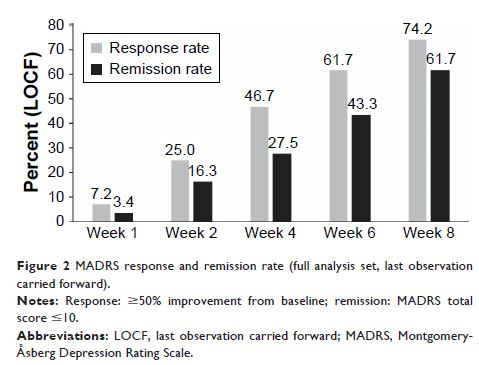108384
论文已发表
注册即可获取德孚的最新动态
IF 收录期刊
- 3.4 Breast Cancer (Dove Med Press)
- 3.2 Clin Epidemiol
- 2.6 Cancer Manag Res
- 2.9 Infect Drug Resist
- 3.7 Clin Interv Aging
- 5.1 Drug Des Dev Ther
- 3.1 Int J Chronic Obstr
- 6.6 Int J Nanomed
- 2.6 Int J Women's Health
- 2.9 Neuropsych Dis Treat
- 2.8 OncoTargets Ther
- 2.0 Patient Prefer Adher
- 2.2 Ther Clin Risk Manag
- 2.5 J Pain Res
- 3.0 Diabet Metab Synd Ob
- 3.2 Psychol Res Behav Ma
- 3.4 Nat Sci Sleep
- 1.8 Pharmgenomics Pers Med
- 2.0 Risk Manag Healthc Policy
- 4.1 J Inflamm Res
- 2.0 Int J Gen Med
- 3.4 J Hepatocell Carcinoma
- 3.0 J Asthma Allergy
- 2.2 Clin Cosmet Investig Dermatol
- 2.4 J Multidiscip Healthc

艾司西酞普兰在中国抑郁症和焦虑症患者的 8 周开放研究中的安全性和有效性
Authors Wang G, You X, Wang X, Xu X, Bai L, Xie J, Yao Z, Yi Q, Ma J, Wang J, Zhuo J, Hu C
Received 5 February 2018
Accepted for publication 9 May 2018
Published 14 August 2018 Volume 2018:14 Pages 2087—2097
DOI https://doi.org/10.2147/NDT.S164673
Checked for plagiarism Yes
Review by Single-blind
Peer reviewers approved by Dr Amy Norman
Peer reviewer comments 2
Editor who approved publication: Professor Wai Kwong Tang
Background: Anxiety symptoms usually worsen depression and functional impairment. The present study was aimed to evaluate the impact of escitalopram on social function and quality of life in major depressive disorder (MDD) patients with anxiety symptoms.
Patients and methods: Adult MDD patients with functional impairment (Sheehan Disability Scale [SDS] score ≥9) and anxiety symptoms (Hamilton Anxiety Rating Scale [HAM-A] score ≥14) received escitalopram (10–20 mg/day) for 8 weeks. Symptom status was assessed by SDS, Quality of Life Enjoyment and Satisfaction Questionnaire-Short Form, Montgomery-Åsberg Depression Rating Scale (MADRS), HAM-A, and Quick Inventory of Depressive Symptomatology-Self Report scales. Safety was evaluated by treatment-emergent adverse events (TEAEs).
Results: Overall, 208 (79.7%) of 261 enrolled patients completed the 8-week treatment. Mean (SD) SDS and Quality of Life Enjoyment and Satisfaction Questionnaire-Short Form total scores were 17.4 (5.87) and 39.3 (14.43) at baseline, which improved to 7.6 (6.71) and 61.6 (15.80), respectively, at week 8. Totally, 59.2% of patients achieved functional remission (SDS≤6) and 61.7% of patients achieved depression remission (MADRS≤10) at week 8; 48.1% of patients achieved both functional and depression remission (SDS≤6 and MADRS≤10). The change in SDS total score was positively correlated with the change in MADRS and HAM-A total scores at each visit. Patient’s baseline SDS score was related with depression score (regression coefficient=0.40582, p =0.0005); remission of SDS was statistically related to a reduction of week 2 and week 6 HAM-A score (p <0.0001) and reduction of MADRS score (p <0.0001). Overall, 25.7% of patients reported ≥1 TEAEs. Most frequently reported TEAEs were nausea (5.8%), diarrhea (2.3%), and dizziness (2.7%). Most TEAEs were mild to moderate in severity. Four patients reported serious TEAEs, two patients reported suicide attempts, and one patient completed suicide.
Conclusion: Escitalopram (10–20 mg/day) treatment was efficacious in reducing depression, improving social function, and quality of life in MDD patients with anxiety symptoms. No new safety signals were identified.
Keywords: anxiety, Chinese, escitalopram, major depressive disorder, social function
